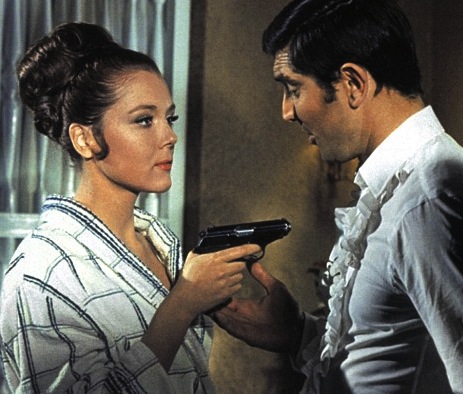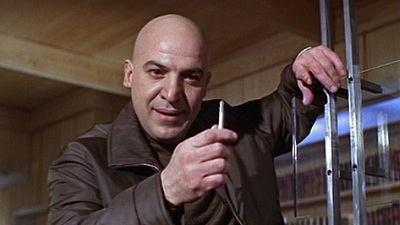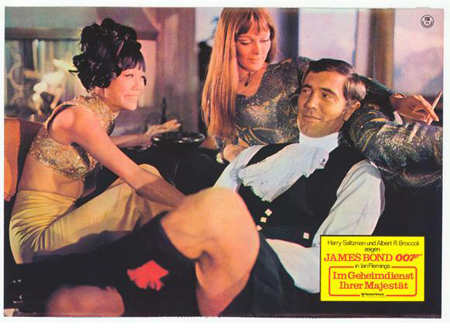by Melanie Crew
Managing Editor
Band. James Band, Atlanta’s own rockin’ masterminds and a riotous tribute to a “not-so-secret agent” dish out a night of nostalgia ‘n’ espionage this Friday, Nov. 6 at The Highlander, along with The Shut-Ups, purveyors of new wave power pop, and a whole lotta down ‘n’ dirty noise pop with Map of the Moon! Grab your friends andyour foes, and boogie on down to the slickest free shindig in town while knocking back a couple martinis in celebration of the release of the 24th highly-anticipated Bond flick, SPECTRE, (dir. Sam Mendes) out in theatres that same night. Exploits begin at 9 pm sharp!
Band. James Band. [James Band (guitar/vocals); Kittens Aplenti (keyboard/vocals); Grillz (bass) and Huge Drag (drums)], began their rockin’ covert operation in 2012 and obviously is heavily influenced by the musical masterminds behind the Bond franchise (John Barry, Shirley Bassey, Paul McCartney, et al.) as well as other ‘60s party bands and tunes. However, they’ve also been known to sling a good ‘80s tune and promise a tantalizing taste of their own “Cold-War Paranoia-Pop” this Friday night! Diamonds may be forever, but this shaken’ (not stirred) shindig is a one-time deal! (This message will self-destruct!)
ATLRetro caught up with Kittens Aplenti for a quick interview about her cronies in Band. James Band.; their favorite not-so-secret spy; and the band’s mission to make sure you die another day so you can spy it up this Friday! And while you uncover our little Q&A with Kool Kat of the Week Miss Aplenti, get an earful of Band. James Band’s take on “Secret Agent Man” during their 2012 East Atlanta Strut performance, here!
ATLRetro: Band. James Band; such an ingenious name for a tribute to a not-so-secret agent! Can you thrill our readers with tales of how you and your own agents got together as a band?
Kittens Aplenti: “Well, the rain exploded with a mighty crash as we fell into the sun. And the first one said to the second one there, ‘I hope you’re having fun.”‘ – Oh, wait, those are the lyrics to “Band On the Run.” Beg your pardon, we don’t usually dwell much on our past. After all, you only live twice. Though it has been rumored that an origin story would be revealed this week, hasn’t it? OK, suffice it to say that Kittens Aplenti once had the opportunity to sing “You’re So Vain” – a song that was probably about James. Then she wanted to perform the theme to “The Spy Who Loved Me,” and she banded together friends and foes to do so – though nobody does it better than Carly Simon.
We see that you’ve overtaken the criminal masterminds with an arsenal of ‘60s party music and film theme songs. Which film’s theme is your favorite and why?
We’re quite fond of the theme from ON HER MAJESTY’S SECRET SERVICE. The constantly descending chromatic lines reflect the movie’s downhill skiing sequences, a testament to the genius of John Barry. The minions in the band like it because it’s abbreviated in the set list as OHMSS; when chanted aloud, it creates the focus and clarity needed for carrying out codas and counterintelligence.
Your top influences are listed as the musical geniuses behind the James Bond franchise; John Barry, Shirley Bassey, Tom Jones, Nancy Sinatra, et. al. Can you tell our readers what drew you to the infamous and slickest spy around, as well as his musical cohorts? And why you want to share the love of the genre with your fans?
These melodies and memories are shared experiences across audiences. They guarantee a good time and much more than a quantum of solace. In addition to theme songs and ‘60s spy favorites, readers should be alerted to Cold-War Paranoia-Pop as well. We are likely to deploy a number of ‘80s favorites for those who are as fond of the Reagan era as we are. For your ears only!
Any adventurous tales of when you began to get interested in playing music?
Our leading man began playing piano like a dutiful lad before picking up an axe. The world is not enough for his talent. He axes while other men just balk. “He looks at this world and wants it all. So he strikes, like Thunderball.”
As purveyors of kitschy tongue-in-cheek underground shenanigans, can you tell our readers who are some of your favorite local bands? And why you love the Atlanta music scene?
A-ha! It would be hard to identify favorites. The camaraderie and formidable talent in the Atlanta scene knock the living daylights out of us. Millionaire developer Mack Zoloft has approached the minions in the band with a scheme. By tearing down all of the local rehearsal spaces to build condos, we can prevent all the other bands from practicing. We’ll dominate!
If you could put together a dream line-up of bands to play with [still around or not], who would it be and why?
We’d love to perform with our local friends Smithsonian and Clashinista. These are both British-inspired send ups as well.
Anything scandalous planned for your shakin’ and not stirred shindig, probing The Highlander on Nov. 6?
The Shut-Ups and Map of the Moon have been licensed to thrill, so you all simply must plan to die another day so
that you can join us. The Man With the Golden Drum is going to shake things up and bang out an electric, nay explosive, addition to the set inspired by a few beloved bonnie Scotsmen.
What’s next for Band. James Band?
Let’s just say our relationships don’t seem to last. There’s always the possibility that we might reboot with a new cast of characters!
Can you tell our readers something you’d like folks to know that they don’t know already?
We could tell you but then we’d have to kill you…This policy does make it a little difficult to promote our shows.
What question do you wish somebody would ask you and what’s the answer?
Q: Do you expect me to talk? A: No, we expect you to listen!















